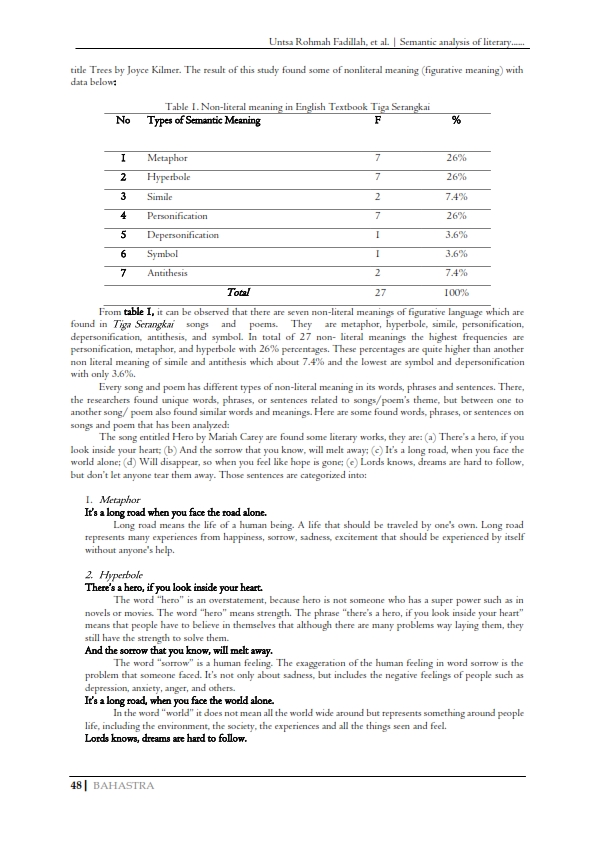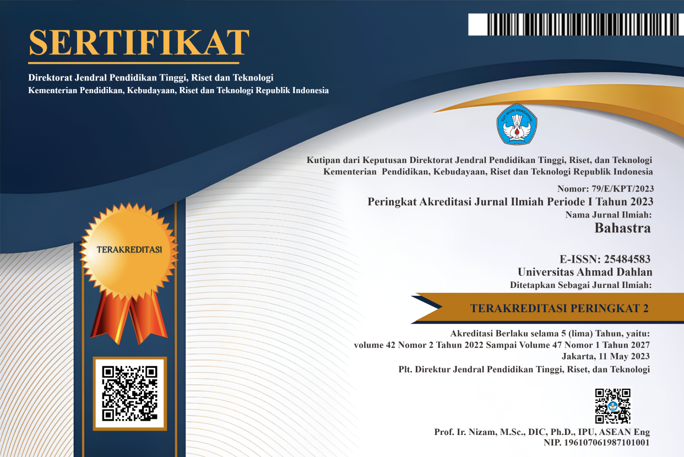Semantic analysis of literary works in selected song lyrics and poems at English textbooks for grade XI of senior high schools
DOI:
https://doi.org/10.26555/bs.v42i1.68Keywords:
English Textbook, Songs, Poems, Figurative Language, Higher Order Thinking Skill (HOTS)Abstract
This study aims to discover the semantic meaning focused on non-literal meaning of figurative language found in selected literary works of song lyrics and poems in the English Textbooks Grade XI of Senior High School published by Tiga Serangkai and the Ministry of Education and Culture. This study applied a descriptive qualitative method. The results of the study indicated several types of figurative language such as metaphor, hyperbole, simile, personification, depersonification, symbol, antithesis, litotes, alliteration, with the highest frequencies are metaphor and hyperbole, while the lowest frequencies are depersonification and symbol. As for the High Order thinking skill practice, it should be seen by implementing song lyric and poem materials in the teaching and learning process which include observation, question, association, experiment, and network. Therefore, it suggested an analysis evaluation and assessment provided in school textbooks to see the use of the textbooks with High Order Thinking Skill (HOTS) practices.
References
Abcarican, R. et al. (1984). Literature the Human Experience. New York: Martin’s
Aprrilianti, L (2020). Comparison between Concept of Evaluation on KTSP Curriculum and 2013 Curriculum. UHAMKA International Conference on ELT and CALL (UICELL)
Avillanova. A.A., Bram.B. (2019). Figurative language in songs in senior high school English student’s book. Soshum: Jurnal Sosial dan Humaniora, volume 9 number 3, pp. 247-255. DOI: http://dx.doi. org/10.31940/soshum.v9i3.1378
Alsayed, F. K. (2019). The effects of semantics in the language development of English as a foreign language (EFL) learners. International Journal of Learning and Development, 9(4). DOI: https://doi.org/ 10.5296/ijld.v9i4.15735
A N S Nisa et al. (2021). IOP Conf. Ser.: Earth Environ. Sci. 747 012079
Borjesson, K. (2011). The notions of literal and non-literal meaning in semantic and pragmatics. Retrieved from https://www.academia.edu/2348834/The_Notions_of_Literal_and_Non_literal_Meaning_ in_Semantics_and_Pragmatics. Accessed on May 5th, 2021
English Language Education Section Curriculum Development Institute Education Bureau. (2010). The Hong Kong Special Administrative Region
Fahmi, Iffa N. (2020). Higher Order Thinking Skill Questions in Reading Comprehension Exercise of “When English Rings a Bell” Textbook. RETAIN. Volume 08 Nomor 04 Tahun 2020, 187 – 193.
Gray, M.C. (1984). A Dictionary of Literal Terms. London: Longman
Gopalan, Y. Hashim, H. (2021). Enhancing Higher Order Thinking Skills (Hots) Through Literature Components in ESL Classrooms. International Journal of Academic Research in Progressive Education and Development, 10(2), 317–329. https://doi.org/10.6007/IJARPED/v10-i2/9673
Hassan, S. R., et al. (2016). The Use of I- think Map and Questioning to Promote Higher-Order Thinking Skills in Mathematics. Creative Education, 2016, 7, 1069-1078. DOI: 10.4236/ce.2016. 77111
Ibrar, S., Mukhaiyar. (2019). Composition of High Order Thinking Skill in English Course Book for the Tenth Grade of Senior High School in Indonesia. ATLANTIS PRESS SARL. Volume 463. https://doi.org /10.2991/assehr.k.200819.016
Kelly, A. Colette (ed). (1996). Children’s Literature: Discovery for a Lifetime. Arizona: Gorsuch Scarisbrick Publisher.
Mackey, A. Gass, S. (2005). Second Language Research Methodology and Design. London: LEA Publisher.
Nabilah, C.H., et al. (2020). Development of Learning Media Based on Articulate Storyline. Indonesian Journal of Applied Research(IJAR), Vol 1 No. 2 2020. https://doi.org/10.30997/ijar.v1i2.54
Nimanuho. (2017). The Analysis of Non Literal Meaning in Christmas Carol by Charles Dickens. Jurnal Ilmiah Bahasa dan Sastra, Volume 4 Nomor 2, pp, 104-115. https://doi.org/10.21067/jibs. v4i2.3182
Nugroho, R.A. (2020). Non-literal Meaning Analysis in the Novel "On the Bright Side, I'm now the Girlfriend of a Sex God”. ELITE JOURNAL: Vol. 2 No. 1 June 2020, pp 23-40,
Puspitarini, Y.D., Hanif, M. (2019). Using Learning Media to Increase Learning Motivation in Elementary School. Anatolian Journal of Education, Vol 4, No. 2. pp 53-60. https://doi.org/10.29333/aje.2019.426a
Sholihah. E. et al. (2021). Relationship Between Higher-Order Thinking and English Achievement. PROMINENT JOURNAL, Vol. 4, No. 1, 45-53. https://doi.org/10.24176/pro.v4i1.5791
Sugeng, B., et al. (2019). Contextual English (Enriched with character building education) for grade XI of senior high schools: regular program. Solo: Tiga Serangkai.
Syarifuddin, S., Hasyim,I. (2020). Semantic Analysis in English High School Handbooks. Jurnal Bahasa dan Sastra Inggris, Volume 9, No 1. pp 1-12 https://doi.org/10.31314/british.9.1.1-12.2020
Sukmawijaya. A., et al. (2020). Analysing Higher Order Thinking Skills on the Compulsory English textbook for tenth graders of Indonesian senior high schools. JOALL (Journal of Applied Linguistics and Literature) Vol. 5 No. 2, pp 137-148. https://doi.org/10.33369/joall.v5i2.10565
Tomlinson. (2012). Material Development for Language Learning and Teaching. Cambridge: Cambridge University Press. https://doi.org/10.33369/joall.v5i2.10565
Yaroslava et al. (2021). School textbook as an object of pedagogical research. SHS WEB OF CONFERENCES 104, 02009 (2021) ICHTML 2021 https://doi.org/10.33369/joall.v5i2.10565

Downloads
Published
Issue
Section
License
Copyright (c) 2022 Untsa Rohmah Fadillah , Nur Afifah Fajar Satiti , Ani Susanti, Tengku Intan Suzila Tengku Syarif

This work is licensed under a Creative Commons Attribution-ShareAlike 4.0 International License.

1.jpg)






